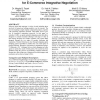1099 search results - page 181 / 220 » On the Complexity of Computing Evolutionary Trees |
BMCBI
2007
14 years 9 months ago
2007
Background: The pyridine nucleotide disulfide reductase (PNDR) is a large and heterogeneous protein family divided into two classes (I and II), which reflect the divergent evoluti...
114
click to vote
AAMAS
2005
Springer
14 years 9 months ago
2005
Springer
Cooperative multi-agent systems are ones in which several agents attempt, through their interaction, to jointly solve tasks or to maximize utility. Due to the interactions among t...
GECCO
2009
Springer
15 years 4 months ago
2009
Springer
Software agents help automate a variety of tasks including those involved in buying and selling products over the internet. The need for handling complex highly configurable produ...
116
click to vote
CONCUR
2007
Springer
15 years 4 months ago
2007
Springer
Abstract. Modelling is becoming a necessity in studying biological signalling pathways, because the combinatorial complexity of such systems rapidly overwhelms intuitive and qualit...
110
click to vote
BMCBI
2010
14 years 10 months ago
2010
Background: Protein-protein interaction (PPI) plays essential roles in cellular functions. The cost, time and other limitations associated with the current experimental methods ha...

